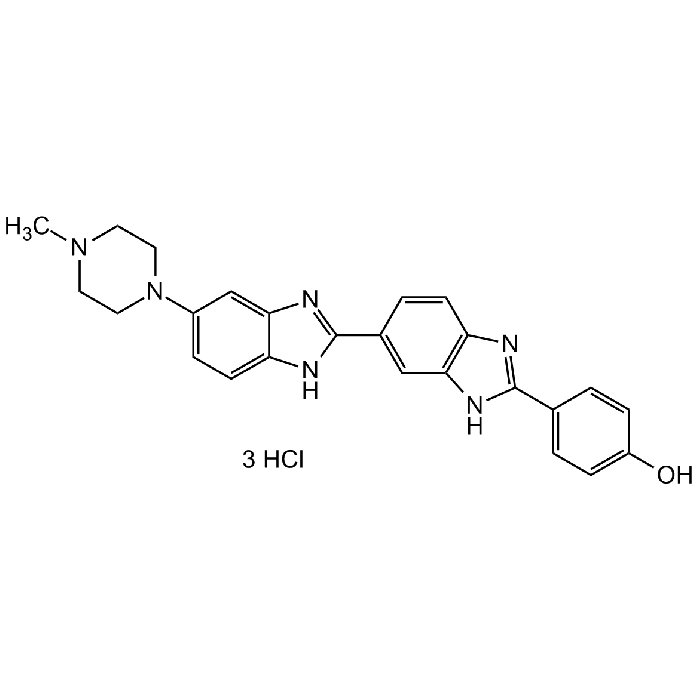Cookie Policy: This site uses cookies to improve your experience. You can find out more about our use of cookies in our Privacy Policy. By continuing to browse this site you agree to our use of cookies.
Chemodex
Hoechst 33258 Solution

| Product Details | |
|---|---|
| Synonyms | 4-[5-(4-Methyl-1-piperazinyl)-1H,1'H-2,5'-bibenzimidazol-2'-yl]phenol trihydrochloride; BisBenzimide H 33258; HOE 33258 |
| Product Type | Chemical |
| Properties | |
| Formula |
C25H24N6O . 3HCl |
| MW | 533.88 |
| CAS | 23491-45-4 |
| RTECS | SM1140500 |
| Source/Host Chemicals | Synthetic |
| Purity Chemicals | ≥98% (HPLC, TLC) |
| Appearance | Liquid. |
| Solubility | Soluble in water. |
| Concentration | 1mg/ml in water |
| Identity | Determined by 1H-NMR. |
| Declaration | Manufactured by Chemodex. |
| Other Product Data |
Click here for Original Manufacturer Product Datasheet |
| InChi Key | INAAIJLSXJJHOZ-UHFFFAOYSA-N |
| Smiles | CN(CC1)CCN1C2=CC=C(NC(C3=CC(NC(C4=CC=C(O)C=C4)=N5)=C5C=C3)=N6)C6=C2 |
| Shipping and Handling | |
| Shipping | AMBIENT |
| Short Term Storage | +4°C |
| Long Term Storage | +4°C |
| Handling Advice | Protect from light and moisture. |
| Use/Stability | Stable for at least 2 years after receipt when stored at +4°C. |
| Documents | |
| Product Specification Sheet | |
| Datasheet |
 Download PDF Download PDF |
The Hoechst stains are a family of fluorescent stains for labeling DNA in fluorescence microscopy. The blue fluorescent Hoechst dye is a cell permeable nucleic acid stain that has multiple applications, including sensitive detection of DNA in the presence of RNA in agarose gels, automated DNA determination, sensitive determination of cell number and chromosome sorting. Useful vital stain for the flow cytometric recognition of DNA damage and other viability measurements by monitoring the emission spectral shifts of the dyes. Because this fluorescent stain labels DNA, it can also be used to visualize nuclei and mitochondria. This dye is commonly used for determining the DNA content of viable cells without detergent treatment or fixation and for fluorescence microscopy or flow cytometry. Hoechst 33258 is a cell-permeable, benzimidazole dye that binds to the minor groove of double stranded DNA with preference for adenine and thymine-rich sequences. It emits blue fluorescence (excitation 352nm/emission max 461nm) when bound to DNA in either live or fixed cells and is useful as a marker of nuclei for cell cycle studies and to distinguish nuclear morphology in apoptotic cells.
(1) A. Kumar et al.: In Vitro Cell. & Developm. Biol. 44(7), 189 (2008) | (2) D. Weidmann et al.: Meth. Enzym. 446, 277 (2008) | (3) D. Plesca et al.: Meth. Enzym. 446, 107 (2008) | (4) K.H. Elstein et al.: Exp. Cell. Res. 211, 322 (1994) | (5) Y.-J. Kim et al.: Anal. Biochem. 174, 168 (1988) | (6) C. Labarca et al.: Anal. Biochem. 102, 344 (1980) | (7) S.A. Latt et al.: J. Histochem. Cytochem. 24, 24 (1976)





